It’s really bad at using system resources effectively. I’m sure this is why it’s so slow at exporting developed photos, and it’s probably also why it’s slow to respond to controls. Here we see Lightroom using barely half the CPU exporting 18 photos—something that is trivially parallelizable to 18 cores (since the photos are independent). In contrast, the old Bibble Pro, which is now available as Corel Aftershot Pro, would always put the whole processor to work.
Tag: Lightroom
Lightroom Raw Processor
Why do Windows software developers hate me? Lightroom refuses to put its catalog on a network disk, and network disk is all I have (well, there’s a small SSD to boot from, but certainly not big enough for the Lightroom catalog). It similarly refuses to put the catalog on an external drive. It does seem to succumb to the linked directory trick though. But still, why does it try to refuse to use the most reliable disk available to me? Idiots.
The need for a central catalog in the first place is one of the main reasons I’ve never really used Lightroom, not even a serious trial. I’ve already got information irrevocably embedded in a proprietary database (I’m contemplating committing serious Python scripting to get the data out), and that’s the last thing I want to commit to.
Plus of course Adobe is out of favor with me right now due to the “cloud” licensing scheme. They’re asking me to pay them 2-5 times as much per year as I’ve been paying them for Photoshop, and telling me I can’t schedule when I can afford to do it. Plus all the usual worries about controlling update scheduling, losing access to saved files if I let my license lapse, and so forth. Basically, Adobe is enthusiastically encouraging a lot of their customers to frantically try to find something, anything, other than an Adobe product that they can live with. I expect that this boondoggle will lead to the creation of the competitors that will eventually kill Adobe.
Using Lightroom 5.0, on the standard 30-day trial. I think I may have had an earlier trial on this computer, but apparently they reset on major version changes or something.
I realized I needed to test Lightroom directly, because the responsiveness issue (which is bidding to be the major problem of many of these packages) isn’t going to be revealed by just using ACR in Photoshop.
In general I hate “all in one” software; it tends to be second-rate at most things, and third-rate at some. Very rarely it’ll be first-rate at something, but basically never more than one thing. I want packages that are really good at what they do, and that work together. Like Photo Mechanic, which is unsurpassed (has no competition, in fact) for the task of sorting and rating photos.
Specific Issues
Catalog
I really don’t want another catalog of my photos, but I don’t have any choice. It does seem to be able to import directories in place, without trying to absorb my existing photos, anyway.
Screen Layout
The filmstrip tries to go across the bottom of the screen, but it can at least be easily changed to auto-hide. Haven’t found a way to move it to the side, or a second monitor, or something yet.
Sliders
Hmm, these seem to ignore the mouse wheel until I’ve dragged them, but then start responding to the wheel. No, I guess it’s clicking on the slider (tiny target) that enables the wheel. Painful!
Responsiveness
Yeah, as expected it’s doing very well here (Photoshop does, and ACR does).
Noise Reduction
As with ACR, quite primitive, not nearly adequate. Preview response isn’t bad, around a second.
Crop
Oh dear, it’s got that stupid crop mode where both the border and the picture move, in opposite directions, when you move the mouse—so that the effective motion of a given mouse motion is twice what you get in general. I think there was a way to turn that off in Photoshop, haven’t found it here yet. What a stupid idea!
Straightening is also part of this module. There doesn’t seem to be a way to use the level tool to define what I think is straight, and then modify the rotation, though. When I’ve got images in the wrong orientation, which happens sometimes, I prefer to use one rotation to fix both their being 90° off and any small departure from straight. Does it really matter? Who knows; a 90° rotation should probably be lossless, but I’m a suspicious curmudgeon.
But the keyboard shorcut to invoke this is “R”. Not “C” as in Photoshop and everything else. Similarly for zoom keyboard shortcuts, incidentally—different from Photoshop and hence from everything that has copied Photoshop.
Ratings
The editing screen doesn’t seem to show ratings, color, selection, and hence also has no way to change them. They’re available in the film strip, but since that’s bolted to the bottom, that has to be hidden to have room to work.
White Balance
The eyedropper tool (click on neutral) disappears after one use, so my very common mode of prospecting around for a good neutral point is ten times slower than normal, and far more annoying.
Example Photos
 Derby
Noise reduction is key to this, and Lightroom has just the basic ACR tools there, which don’t hack it.
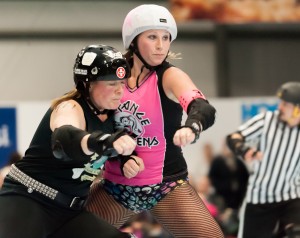
 Dr. Mike
Even on a jpeg, Lightroom gives me Highlight control. It doesn’t seem to actually accomplish much, though.
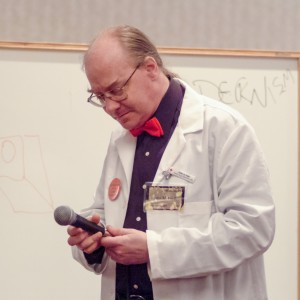
Minnehaha
This one is always tough; it’s badly exposed, really not something that can be rendered into an art-print grade result. However, lots of useful photos have problems that way, so that makes it a good test.
On this one, even dragging the shadows up to 100 didn’t help much. I’ve ended up with highlights -100, shadows +100, and exposure +1.15. And clarity kicked way the hell up, too, at 64. I tried both the DNG and the original RAF, and they behave the same, which is nice.
Almost starting to look like something, and I haven’t made the burned out highlights in the water above the lip much worse.

 Naomi
Always easy. Still easy. Probably not a good test photo, but kind of too late to replace it with something now.
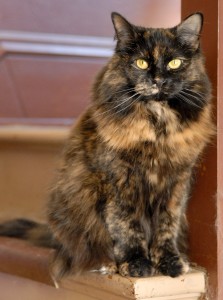
Doc Smith Books
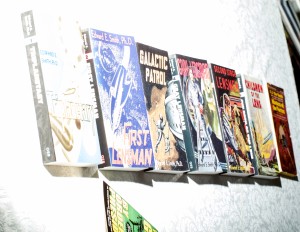
Tux Cat
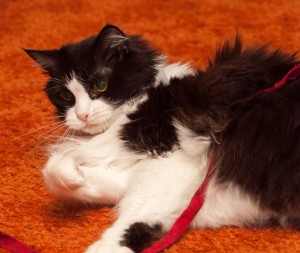
Choosing a New Raw Processor
My photographic workflow has some kinks and splits. The main one is between the handling of proofs, event photos, and snapshots, on the one hand, and the treatment given to final versions of important pictures (whether they’re art, restorations, portraits, or whatever). Since I’m an imperfectly fossilized dinosaur, I think of the two as “machine prints” and “custom prints”, the two categories you could get from a pro lab in the 1970s.
Custom prints require the full power of Photoshop for me. Since Adobe, in their death throes, has shot off their right foot (that being Photoshop), I’ll be continuing to use CS6 for the foreseeable future. I can use the other fork of my workflow to produce 16-bit raw conversions as the input to CS6 (so I can continue to use it far beyond where ACR supports my camera bodies).
The “machine print” side has long run through Bibble Pro (and more recently Aftershot Pro, which is what Corel called it after they bought Bibble). This side works by making fairly quick adjustments by eye to groups of photos; often I’ll start with settings for an entire session, and then make additional adjustments to photos from different parts of the session, and then sometimes all the way down to individual series of shots. This is much faster than doing full custom printing on each shot! But it’s also much better than just using the jpegs that come out of the camera. This is attempting to make “good” machine prints, like the video-analyzed prints from a pro lab, where a person looked at the print and actually maybe turned dials while watching a video screen. For maybe a full second.
Since Bibble Labs sold themselves to Corel, and then Picturecode wouldn’t renew the agreement about integrating Noise Ninja, Aftershot Pro is no longer a great candidate for my raw processing, and I’ve been wondering where to go next. The obvious place to go was Adobe’s Lightroom—except that even before the “Creative Cloud” disaster I was unhappy with their upgrade policies and their policy of not supporting old versions with new cameras. While I’m not pissed enough, I think, to actually cut off my nose, I’d at least strongly prefer not to give Adobe my money if I can reasonably avoid it.
Having no other pressing business to entertain me, I decided to go through and make an attempt to evaluate what I saw as the interesting candidates for my new raw processor.
| Product | Version Evaluated | Price (June 2013) | Supported OSs |
|---|---|---|---|
| Aftershot Pro | 1.1.0.30 | $50 | Windows |
| Bibble Pro | 5.2.3 | Not available | Windows, Linux |
| Dark Table | Free | Linux, OS X, Solaris | |
| Photo Ninja | 1.0.5 | $130 | Windows, OS X |
| Capture One Pro | 7.1.2 build 67846 | $300 | Windows, OS X |
| LightZone | 4.0 | Free (BSD license) | Windows, OS X, Linux |
| Lightoom | 5.0 | $150 (but frequently on sale for less) | Windows, OS X |
This is far from an exhaustive list. In particular there are a number of free-software packages available, many of which don’t support Windows.
Capture One Pro is the “big gorilla” here, to my eye. It’s what supports most of the expensive medium-format digital cameras and backs, and it’s apparently what was nearly universally used in digital production environments (catalog shooters and such, who went digital very early because their high volumes justified the high price).
My evaluation methodology is going to be very casual. I’ve chosen a few pictures that I’m going to go through and process with each processor. I’ll no doubt acquire opinions along the way, which I will publish, and I’ll show the results and discuss what I see in them some. This is not either a deep or an especially scientific analysis, and is very me-centric.
I’ll be posting an article every few days on this for a while; first a series of articles about one raw processor I evaluated, and eventually the big conclusion article. Hope this is all of use to somebody!
